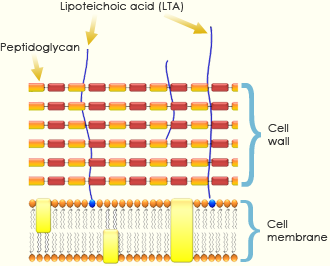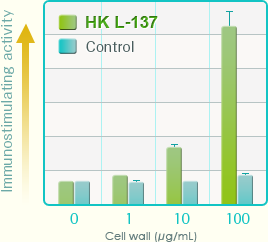


We have tried to clarify why HK L-137 has the stronger immunostimulating activity compared to other lactic acid bacteria.
By examining the relationship between various components of L-137 and its immunostimulating activity, we have revealed that lipoteichoic acid (LTA) is a key component for immunostimulation. As shown in figures right, LTA exists in and outside the cell wall of bacteria. L-137 expresses a much higher amount of LTA outside the cell wall than do other general lactic acid bacteria. We have verified that higher expression of LTA is attributable to the stronger immunostimulating activity of L-137.

Spleen cells were stimulated with cell wall of L-137 or a general lactic acid bacterium.

The cell wall of L-137, which possesses characteristic LTA, showed a high immunostimulating activity.
Spleen cells were stimulated with peptidoglycan, a main component of the cell wall, purified from the cell wall of L-137 or a general lactic acid bacterium.

Peptidoglycan of L-137, which has no LTA, showed similar immunostimulating activity to that of a general lactic acid bacterium.
Microbiol Immunol 54: 143-151 (2010)
